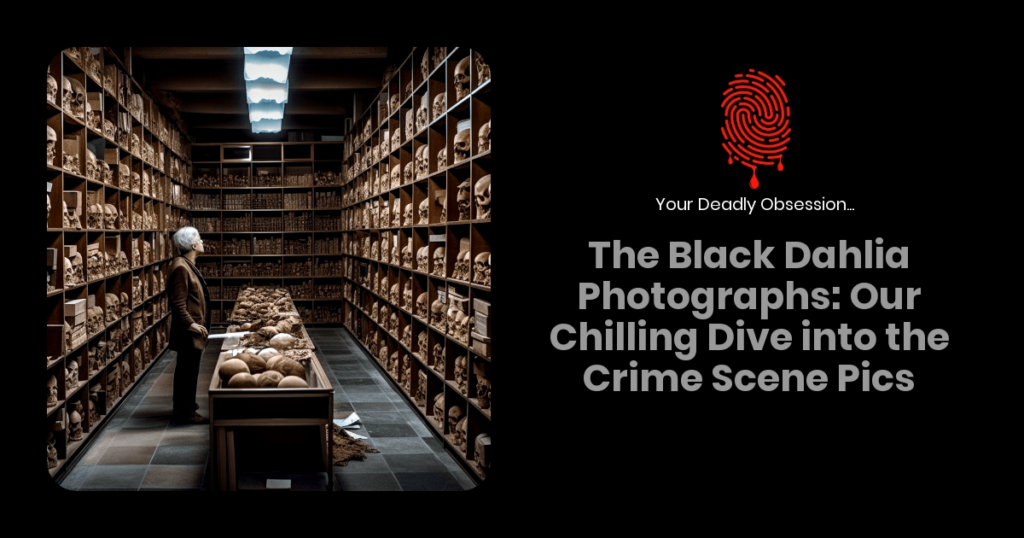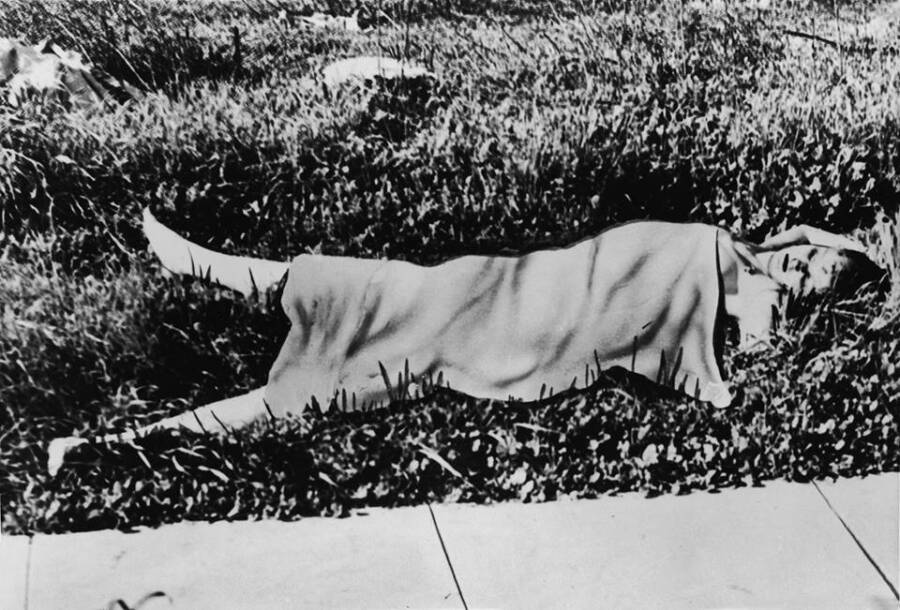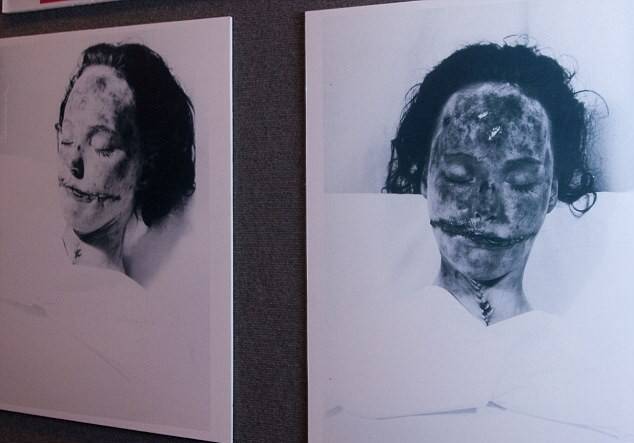We’ve all heard about the infamous Black Dahlia case, with its countless theories and unsolved mystery. But, have you ever taken a closer look at the photographs associated with the case? These chilling images don’t just bring us into the gruesome world of Elizabeth Short’s murder, they also tell a story of their own.

As we delve into the Black Dahlia photographs, we can’t help but find ourselves drawn into the dark world that surrounded Elizabeth Short in the 1940s. From the haunting pictures of her striking facial features, to the images of her unimaginable crime scene, these photographs both shock and intrigue us. It’s hard not to wonder what secrets these images might hold, as they’ve captivated the public’s imagination for decades.
What makes the Black Dahlia photographs so noteworthy is their ability to offer us a rare peek into the past, while still leaving us with an abundance of unanswered questions. As we examine these images, we can only speculate about what truly happened to Elizabeth Short and who the heartless murderer might have been. In the end, we’re left with a chilling reminder of a crime that still, to this day, remains unsolved.
The Mystery Surrounding the Black Dahlia Photographs
When it comes to cold cases and crime mysteries, the Black Dahlia is one of the most intriguing stories out there. If you’re into this kind of stuff, you’re undoubtedly familiar with the gruesome murder of Elizabeth Short in 1947. The photos associated with this case have captured our imagination and speculation for decades. Let’s dive into the mystery behind these enigmatic photographs.
Many of these photographs were taken by the LAPD for evidence, but some of them weren’t released to the public until decades later. A few notable images captured in the investigation include:
- Pictures of Elizabeth’s personal effects found at the crime scene
- Gruesome images of her mutilated body
- Photos from newspapers that sensationalized the case
- A mysterious postcard sent by a potential suspect
Even today, 75 years later, the photographs convey a chilling sense of violence and terror. They remind us how little we know about the person responsible for this heinous murder.
What remains unsolved in this mystery is the true identity of the killer. Over the years, there have been numerous suspects, but no one has ever been charged with the murder. Throughout their investigation, the LAPD has claimed to have come close to solving the case, only to hit dead ends. New theories and evidence continue to emerge in the form of books, documentaries, and online discussions. We can’t help but ponder:
- Were the police withholding information from the public?
- Did the killer slip through their fingers because of their own mistake?
- Is there a connection to other unsolved murders from the same period?
Adding to the mystery, several people have claimed to know the killer’s identity. But these claims are often contradictory, leading to more questions than answers. Notorious suspects put forward by various sources include:
- George Hodel, a doctor who lived in the area
- Fred Sexton, an artist and friend of Man Ray
- Jack Anderson Wilson, a struggling writer with a criminal past
As die-hard fans of cold cases, we may never know the truth behind the Black Dahlia murder. The photographs and documents shared will continue to fuel speculation about this dark and grisly case. It’s a chilling reminder that, beneath the surface of a seemingly normal city, something sinister might be lurking. The Black Dahlia photographs will continue to haunt our imagination as we long for answers and justice for Elizabeth Short.
The Crime Scene and Disturbing Images
It’s time we dive into the haunting details of the Black Dahlia photographs and the crime scene that’s captured the imagination of cold case enthusiasts for decades. In this section, we’ll discuss the chilling images that have been etched in the memories of those who’ve followed this unsolved mystery.
On the morning of January 15, 1947, the mutilated body of 22-year-old Elizabeth Short, also known as the Black Dahlia, was discovered in a vacant lot in Los Angeles. What made this crime scene so disturbing were not only the facts that her body was cut in half and drained of blood, but also that her mouth had been slashed from ear to ear. After the police found her remains, some unsettling photographs were taken depicting the gruesome scene.

Several key elements of the crime scene photos are worth noting:
- Sheer brutality: The murder of Elizabeth Short was undeniably brutal; reports suggested it took the killer more than three hours to complete the dismemberment.
- Sense of staging: The killer posed Short’s body in a morbid display, showcasing the horrific damage inflicted on her. The photographs show that her doubled-over upper half was laid out carefully in a position that eerily resembles someone in repose, and her legs were spread apart, indicating a deep level of depravity.
Throughout the years, various crime scene photos and morgue images of Short have been circulated among the public, fueling intense curiosity and speculation about the case. However, these photographs also serve as grisly reminders of the torment she endured, and the heinous nature of the crime.
In examining the disturbing images, we also observe the significant amount of attention put into erasing the victim’s identity. Short’s body was meticulously cleaned, fingerprints were burned off, and her tattoos were removed, all pointing to the calculated nature of this horrific crime.
As die-hard fans of cold cases and mysteries, we’re drawn to the chilling visuals of the crime scene, relentlessly searching for clues that may help unravel this unsolved enigma. We know that these haunting images represent the darkness and evil that can exist in our world, and despite the macabre nature of the photographs, we’re compelled to learn more.
Take a moment to consider the eerie significance and chilling legacy of the Black Dahlia photographs as we delve deeper into this unsolved case. As each image tells its sad and terrifying story, we find ourselves both transfixed and repulsed by the horrifying details that continue to haunt us.
The Role of the Media in the Black Dahlia Case
We’ve seen how the media can make or break a case, and in the case of the Black Dahlia photographs, they played a significant role. Let’s dive into how exactly the media impacted this infamous unsolved mystery.
Back in 1947, when the Black Dahlia investigation was gaining momentum, newspapers were the primary source of information dissemination. Sensational headlines were crucial in driving sales, and the Black Dahlia case provided the perfect story. Newspapers like the Los Angeles Examiner and Los Angeles Times published explicit photos, speculation, and occasionally false information to keep readers hooked.
With the newspapers’ coverage, the case gained widespread attention. Journalists even gave the victim, Elizabeth Short, the nickname “Black Dahlia“. They elaborated on her life, dramatizing certain aspects – such as alleged promiscuity – in order to create an image of the alluring yet tragic femme fatale. This not only helped sell more papers but also influenced public perception of the victim.
The growing attention surrounding the Black Dahlia case led to multiple “witnesses” coming forward:
- Some claimed they had seen the victim the night before her body was found
- Others believed they saw the victim with her alleged killer
- A few even confessed to the crime, though none of them were found to be credible
Unfortunately, not all information shared by these witnesses was accurate. In fact, some testimonies were exaggerated, and others completely fabricated. The media’s willingness to report on these claims as “news” without thorough fact-checking further muddied the waters of the case.
During the investigation, the media frequently received letters from people claiming to be the killer. They would then publish the letters, and sometimes, the photographs accompanying them. This created a feedback loop where the continued sharing of such content perpetuated public interest in the case.
The intense media coverage proved to be a double-edged sword. On one hand, it raised awareness of the case which could have potentially led to the apprehension of the perpetrator. On the other, the media’s desire for a thrilling story meant the investigation became saturated with false leads, misinformation, and an overabundance of “eyewitnesses” whose testimonies were unverifiable.
To sum it up, media coverage played a pivotal role in the Black Dahlia case. From sensational headlines to the publishing of grisly details, the media fueled interest in this unsolved mystery. Despite potentially hindering the investigation, the media’s involvement in the case has made the Black Dahlia one of the most talked-about cold cases in history – ensuring that Elizabeth Short’s tragic story remains etched in the hearts and minds of crime enthusiasts everywhere.


Influence on Popular Culture and Modern Media
The Black Dahlia’s mystery has captivated us and left a significant impact on popular culture and modern media over the years. From books to movies, numerous adaptations and fictionalized accounts of the case have emerged.
Some of the most notable creations include:
- Black Dahlia Avenger: A true crime book written by former LAPD Homicide Detective Steve Hodel. Hodel actually accused his own father, Dr. George Hodel, of being the real killer.
- The Black Dahlia (2006): A film adaptation by Brian De Palma, based on James Ellroy’s 1987 noir novel of the same name. The movie stars Scarlett Johansson, Aaron Eckhart, and Josh Hartnett.
- I Am the Night (2019): A limited TV series directed by Patty Jenkins, inspired by the Black Dahlia case. It features a narrative that intertwines the murder with the lead character’s search for her own identity.
In addition to these specific creations, the Black Dahlia murder has seeped into other aspects of our collective imagination. The unsolved case has become a cultural touchstone for various art forms, including song lyrics and music videos. Some songs like “Black Dahlia” by Angel Haze, and “The Ballad of Black Dahlia” by Nick Cave and the Bad Seeds allude to the tragic story.
The case’s harrowing nature has also influenced television programming that focuses on unsolved mysteries and true crime phenomena. Shows such as “Unsolved Mysteries,” “Crime Traveller,” and even “American Horror Story” have only fueled our fascination with this grisly and perplexing murder.
Lastly, conspiracy theories surrounding the case are not uncommon. Countless online forums, social media posts, and discussions continue to explore the Black Dahlia photographs and their possible implications. Theories range from an unknown serial killer being the culprit, to bizarre extraterrestrial involvement.
The impact of the Black Dahlia’s photographs on popular culture and modern media remains evident. Even after all these years, our fascination with the case never wanes, and we continually seek answers to one of the most famous unsolved murders in American history.
Theories and Possible Suspects
Ah, the Black Dahlia photographs… A mystery that’s captivated us and die-hard fans of cold cases, crime, and mystery for decades. So who might be responsible? Well, let’s take a look at a few theories and possible suspects that have emerged over the years.
One of the most prominent theories is that the killer could have been a doctor or someone with medical knowledge because of the way Elizabeth Short’s body was mutilated and cut. It was through precise surgical incisions, indicating that the perpetrator may have been skilled in that field. Some of the main suspects in this theory include:
- Dr. George Hodel
- Dr. Walter Bayley
- Dr. Francis E. Sweeney
Another possible suspect is Leslie Dillon, a bellhop who confessed to the murder to his friend, Jeff Connors. Dillon later recanted the confession, but he knew details about the crime scene that hadn’t been released to the public – which is definitely suspicious.
Norman Chandler, publisher of the Los Angeles Times in the 1940s, has also been mentioned as a suspect. The theory claims that he had an affair with Elizabeth Short, which resulted in a pregnancy. To avoid scandal, Chandler supposedly had Short killed.
But there’s more. Let’s not forget about the Cleveland Torso Murders, which were a series of brutal, unsolved murders that took place between 1935 and 1938. Some believe that the same person who committed the Cleveland murders was also responsible for the Black Dahlia killing.
And of course, there’s always the possibility of random unknown suspects who we may never know about. Considering how the case has gone unsolved for such a long time, this idea isn’t completely implausible.
Here’s a quick overview of some of the main suspects we’ve mentioned:
| Suspect Name | Possible Motive | Connection to Case |
|---|---|---|
| Dr. George Hodel | Unknown; possibly medical fascination | Medical knowledge, possible surgical skill |
| Dr. Walter Bayley | Unknown; possibly medical fascination | Medical knowledge, possible surgical skill |
| Dr. Francis E. Sweeney | Unknown; possibly medical fascination | Medical knowledge, possible surgical skill |
| Leslie Dillon | Unknown | Confessed, then recanted; knew unreleased crime scene details |
| Norman Chandler | Hiding affair and pregnancy | Affair with Elizabeth Short; potential scandal |
| Unknown Suspect | Random act of violence | Connection undiscovered |
No matter which theory catches your attention, it’s important to keep in mind that the Black Dahlia case remains unsolved. However, hope is not lost. We’ll continue to search for answers to satisfy our curiosity – and to bring a sense of closure for Elizabeth Short and her family.
Concluding the Black Dahlia’s Unsettling Legacy
We’ve delved deep into the Black Dahlia photographs, and it’s now time to wrap up our exploration of this chilling case. Let’s take a moment to reflect on the impression these photos have left on us and the unsettling legacy they represent.
The gruesome details of the crime scene and the shockingly graphic photos have undoubtedly left an indelible mark on our memories. We can’t help but feel sympathetic to the plight of Elizabeth Short, a young woman seeking fame and fortune, only to meet such an unfortunate and gruesome end.
As die-hard fans of cold cases, crime, and mystery, we recognize the importance of preserving the details of this unsolved case. After all, it’s not just about satisfying our curiosity; it’s about finding closure for Elizabeth’s family and seeking justice for her tragic death. Here are some key points to remember from the Black Dahlia mystery:
- The infamous crime took place in 1947, leaving an enduring enigma for the past 70+ years
- Elizabeth Short’s mutilated body was discovered in Los Angeles, California
- The killer remains unidentified and the case unsolved
Even though the black and white photographs of the crime scene may be unnerving, their availability has played an essential role in maintaining public interest in not only the Black Dahlia’s case but also other similar unsolved crimes. This undying fascination has motivated further research and investigations, rekindling hope that someday, these cold cases will be solved.
In the end, our fascination with the Black Dahlia photographs and the mystery surrounding her death serves as a reminder that the search for justice prevails. We won’t let her story fade away until her killer is identified and brought to justice. Sometimes, confronting the dark and chilling side of these mysteries is necessary to ensure that those like Elizabeth Short are never forgotten.
References:
https://en.wikipedia.org/wiki/Black_Dahlia
https://www.fbi.gov/history/famous-cases/black-dahlia

Owner & entrepreneur with a passion for murder mystery! Seriously, who doesn’t love murder mystery?
Chris is a proud member of the American Medical Writer’s Association (AMWA), the International Society for Medical Publication Professionals (ISMPP), the National Association of Science Writers (NASW), the Council of Science Editors, the Author’s Guild, and the Editorial Freelance Association (EFA).

